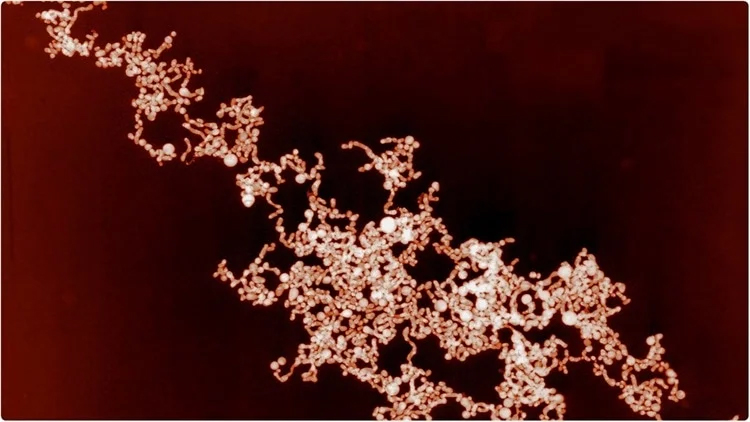Using metal nanoparticles to fight SARS-CoV-2

A recent review article looks at the potential of nanotechnology in fighting severe acute respiratory syndrome 2 (SARS-CoV-2), with several possibilities of strategies in therapeutics, vaccines, and prevention.
The review article, published in the journal Nanomaterials provides insights into recent studies using metal nanocomposites as antivirals. In addition to discussing SARS-CoV, middle east respiratory (MERS)-CoV, and coronaviruses, other enveloped and RNA viruses are also included as targets for metallic nanomaterials in this review.

Introduction
The novel coronavirus, SARS-CoV-2, that emerged in late December 2019 in Wuhan, China is responsible for coronavirus disease 2019 (COVID-19). Belonging to the Coronaviridae family, seven viruses are capable of infecting humans: human coronavirus 229E (HCoV-229E) and human coronavirus NL63 (HCoV-NL63), (belonging to the genus Alphacoronavirus), and human coronavirus OC43 (HCoV-OC43), human coronavirus HKU1 (HCoV-HKU1), Middle East Respiratory Virus (MERS-CoV), SARS-CoV and SARS-CoV-2 (belonging to the genus Betacoronavirus).
Among these, SARS-CoV, MERS-CoV, and SARS-CoV-2 cause severe respiratory disease with complex pathophysiology associated with multiple organ failure, sepsis, and death. Despite a low mutation rate (compared to the Influenza virus), variants with increased transmissibility, increased severity, and reduced antibody neutralization for COVID-19 are identified to be emerging globally.
The versatility of nanocomposites and nanoparticles enables them to fight infections and prevent viruses, including VOCs, without selective toxicity and adverse effects. In addition, the fact that the virus uses the host cell machinery for its replication is essential for developing an antiviral drug that does not harm the host.
Unique size, high surface-to-volume ratio, surface plasmon resonance, and malleable optical absorption spectra of metallic nanoparticles are some of the advantages in using nanotechnology for antiviral strategies – bioconjugation, nanocarriers or drug stabilization, production of hosts reactive oxygen species (ROS), etc. General human pathogenic coronavirus replication. Attachment and entry through S protein binding to specific host receptor. Positive sense viral RNA released and polymerase is translated. Viral RNA is replicated and nucleocapsid (N) structural protein is synthesized in the cytoplasm, and S protein, membrane (M) and envelope (E) are transcribed/translated in the endoplasmic reticulum (ER) and transported to the Golgi. Viral components are packed and assembly in a mature virion structure that is then released
General human pathogenic coronavirus replication. Attachment and entry through S protein binding to specific host receptor. Positive sense viral RNA released and polymerase is translated. Viral RNA is replicated and nucleocapsid (N) structural protein is synthesized in the cytoplasm, and S protein, membrane (M) and envelope (E) are transcribed/translated in the endoplasmic reticulum (ER) and transported to the Golgi. Viral components are packed and assembly in a mature virion structure that is then released
Metal Nanoparticles as Antivirals
Metal nanoparticles can attack multiple viral targets with minimal subsequent resistance development.
The best metal nanoparticles effective against bacteria and viruses are silver nanoparticles (AgNPs). The antiviral and inhibitory activity of AgNPs is shown against TGEV, porcine coronavirus, as a model of CoV and feline coronavirus (FCoV). AgNPs synthesized by curcumin was shown to be less toxic than AgNPs than citric acid.
Graphene oxide (GO) is also demonstrated to be effective against coronaviruses (porcine epidemic diarrhea virus–PEDV) and FCoV.
A complex of gold nanoparticles (AuNP) is shown to interact with Dengue virus (DENV-2) envelope protein, inhibiting the virus permanently. Studies have also shown that porous AuNPs without surfactants decreased the infectivity of various influenza virus strains (H1N1, H3N2, and H9N2).
The reviewers presented various studies involving nano metallic materials as antivirals and the proposed mechanisms of action.
Nanoparticulated Delivery Systems against Viruses
Difficulties in common antiviral drugs include solubility, permeability, and absorption, affecting the drug’s bioavailability. Nanoparticulated delivery systems for the bioactive compounds, immunogenic drugs or proteins, may overcome these challenges. Nanocarriers are well-studied and effective against HIV and dengue virus (DENV) with a cationic complex AuNP-siRNA.
Because no known drugs effectively interfere with SARS-CoV-2 replication, the reviewers have not directly addressed it as a drug-nanocarrier for SARS-CoV-2.
Nanovaccinology
In the ongoing pandemic, vaccination has been the most effective medical intervention to control the infection. Nanoparticles are extensively explored as vaccine adjuvants, for example, lipid-based and polymeric nanomaterials.
Conjugated 100 nm gold nanoparticles with S (spike) glycoprotein of avian coronavirus have elicited a robust immune response in mouse models.
A recent study proposed a vaccine that unites the immunomodulation of AuNPs, capped with antiviral polysaccharides and loaded with S or N (nucleocapsid) proteins from the SARS-CoV-2.
Metallic Nanoparticles in COVID-19 Diagnosis
Combining diagnosis with the ability to tailor a metallic nanomaterial with specific properties could be a vital weapon in the fight against COVID-19.
Presently COVID-19 diagnosis can be performed based on the viral’s sequences, patients’ antibodies, or SARS-CoV-2 antigens detection from nasopharyngeal or oropharyngeal swab samples from patients (the gold standard of sampling).
Likewise, magnetic nanoparticles are easy and effective in SARS-CoV-2 detection through electrochemical, fluorescence, or magnetic resonance properties. The magnetic particles can be used to extract SARS-CoV-2 RNA from samples and help increase the sensitivity of detection based on the amplification methods.
Metallic Nanoparticles in Personal Protective Equipment
Despite vaccination rollouts, personal protective equipment (PPE) is mandatory to arrest the viral spread via carriers. Reports demonstrated anti-SARS-CoV-2 activity of incorporating metal nanoparticles in those PPEs. Various nanomaterials such as silver nanoparticles, copper oxide, iodine, titanium oxide are discussed for use in these PPE products.
Futures Perspectives
Developing an antiviral drug for viruses that are obligate intracellular parasites that rely on host-cell machinery for replication is difficult, so nanotechnology may be a potential solution.
Nanomaterials’ tunable properties and demonstrated potential make them a promising alternative to current antivirals. The use of these tools could be used to prevent future epidemics and pandemics.
Journal reference:
- Chue-Gonçalves, M.; Pereira, G.N.; Faccin-Galhardi, L.C.; Kobayashi, R.K.T.; Nakazato, G. Metal Nanoparticles against Viruses: Possibilities to Fight SARS-CoV-2. Nanomaterials 2021, 11, 3118. https://doi.org/10.3390/nano11113118, https://www.mdpi.com/2079-4991/11/11/3118